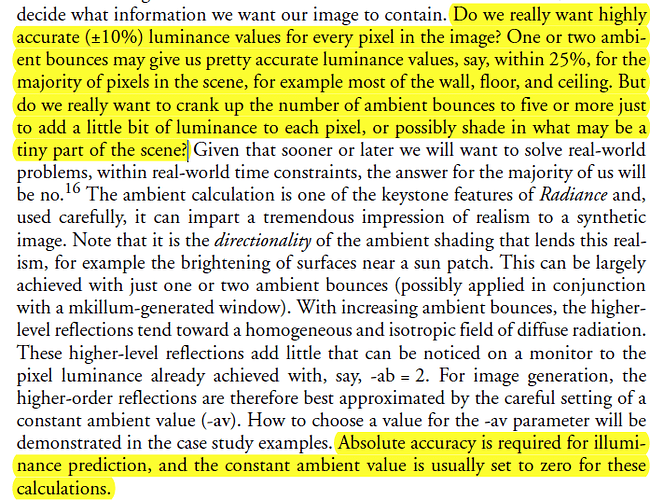Why is setting -aa and -ar to 0.05 and 256 instead of 0 makes the simulation time longer? As you know 0 is the maximum possible input for the parameter but 0.05 and 256 take longer.
Setting either of two to zero turns off the ambient caching algorithms in Radiance and makes the calculation pure Monte-Carlo raytracing.
With standard, point-in-time, simulations with Radiance it’s preferable to keep the ambient caching on instead of relying on pure Monte-Carlo approach (which is essentially a brute force method).
You can get a better idea about ambient calculations in Radiance from John Mardaljevic’s tutorial presentation.
Regards,
Sarith
@sarith thank you very much. Just one more question, does ambient resolution affect the accuracy of results or only rendering? I saw it on Mardaljevic’s tutorial and apparently, it only creates smoother images and does not affect the accuracy of results; am I right?
Well, assuming you are referring to accuracy of illuminance calculations and renderings, technically both illuminance and renderings are results. In the case of renderings, luminance values get written to pixels and in the case of grid-based calculations, illuminance values get written to photosensor locations.
I guess the precision of illuminance values are more important than that of images, as illuminance is often calculated for the purposes of validation/comparison while images are generated to get a perception of how a space might look like. You might want to refer this discussion from John Mardaljevic’s dissertation (Page 31 in pdf):
Regards,
Sarith
@sarith Thank you very much. I have one more question; what is the Direct Pretest Density or -dp in Radiance? is it similar to aa that setting it to 0 technically disable it?
I tried analyses with it but apparently it does not affect the illuminance level on the analysis grid.
Hi @Farzam, as per the manpage the -dp option is defined as:
Set the secondary source presampling density to D. This is the number of samples per steradian that will be used to determine ahead of time whether or not it is worth following shadow rays through all the reflections and/or transmissions associated with a secondary source path. A value of 0 means that the full secondary source path will always be tested for shadows if it is tested at all.
It 's unlikely that the -dp will have any bearing on your simulation. Unless you are working with a lot of reflective surfaces in your scene, there won’t be many second sources in your simulation.
